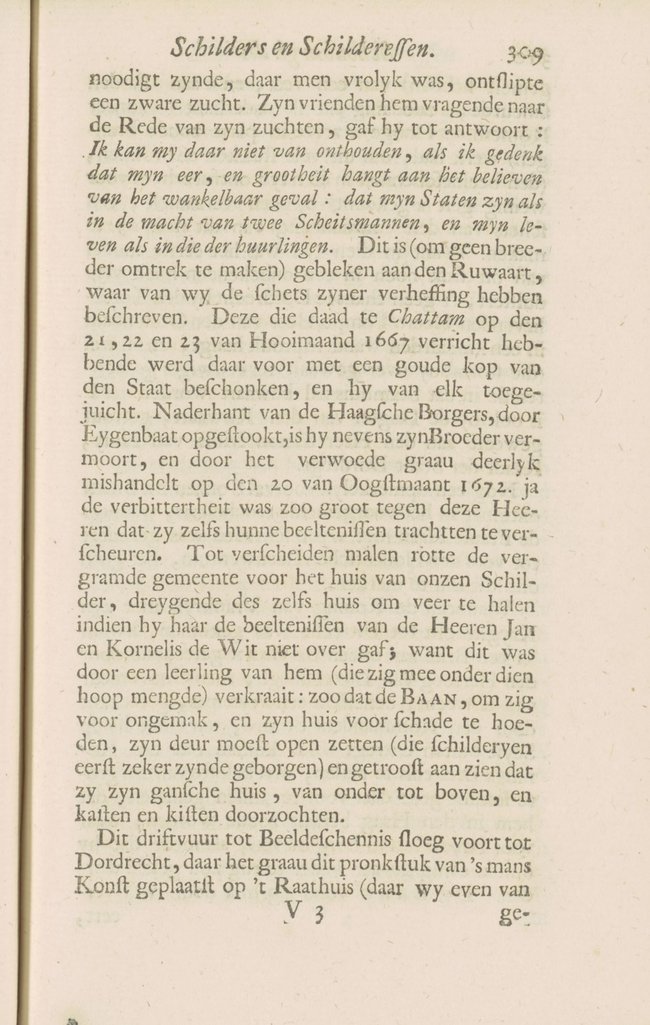Volume 2, page 300-309
Page 300
the cock crow that made Peter’s crime memorable.
Just as one link follows on another, so one digression flows from the other, and thus we have strayed a little from our goal, which was finally to indicate by an example or two how uncertain it is that all the works that are sold as Italian art should be real, or be taken for the best kind of art works by the most famous masters.
It is known that the most important art work by which the Italians garnered so much fame in the world were painted for the churches, cloisters and palaces of the most powerful families of Italy and are therefore in stable hands. It follows that it is for the most part junk with which commerce is carried on in other countries. I do not deny that now and then a top art work or works, bought up over there and secretly transported arrives here, which true connoisseurs show off in their cabinets. But that they can be obtained so readily and in such numbers that one can mount whole sales, as happens, gives enough reason to suspect that there is fraud at play. In addition it seems ridiculous to me when the catalogues hammer on with the name of Raphael of Urbino, as if those pieces are as easily obtained as a farmer’s kermes by Joost Cornelisz. Droochsloot or flower pieces by Bartholomeus Assteyn. In addition it is known that there is a prohibition in Rome against the export of the best or most famous art works, and also that inspectors have been appointed to that end who have the right to detain them for the price that
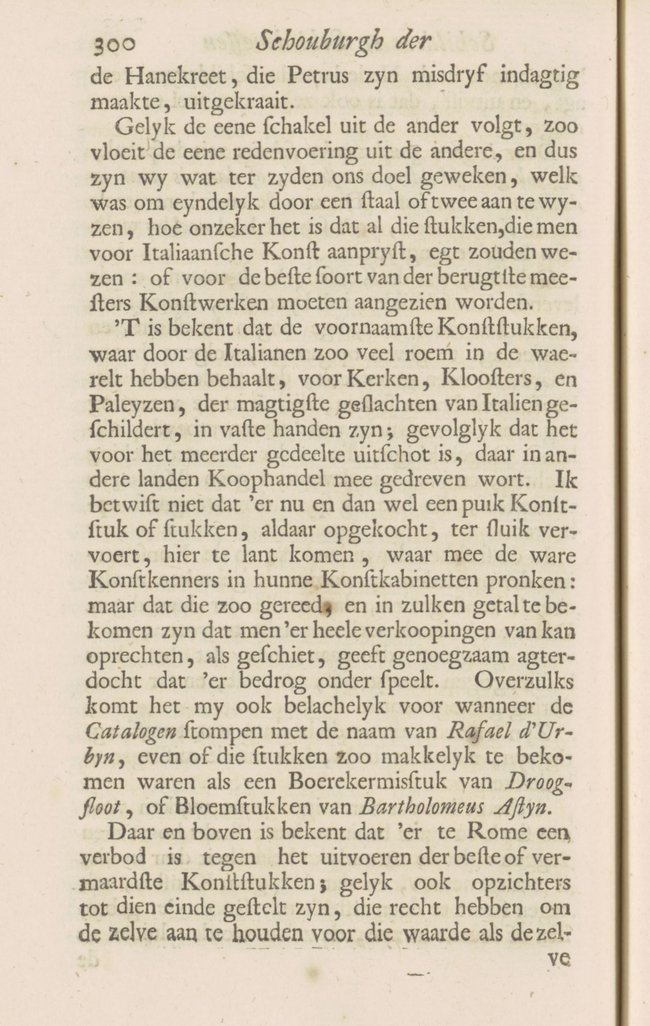
Page 301
is assessed for them or for the price at which they were purchased, and that is not only with respect to paintings but also to drawings.
A proof of my claim happened to the painter JOHN CLOSTERMAN in the year 1700. He had bought up a large number of drawings by the first masters for some hundred of scudi. But they were detained at the charge of Pope Clement XI and a part of them hung in the room of the Academy and the Vatican rooms painted by Raphal, in the service of art practice.
As far as Raphael is concerned, most of his art works are done in fresco and those that he painted in oil on canvas or panel are in such fixed ownership that detaching them is out of the question. For those who own them have so much esteem for them that various of Raphael’s art works are protected by an iron picket fence so that they may not be damaged through carelessness, being treasured or esteemed as if sacred. Within Rome there is little by him to be seen beyond his large works in the Vatican and the high altarpiece in San Pietro in Montorio [1], but a small piece in the bedchamber of the pope in the Vatican, of which it is still doubted if it is authentic or whether or not it was copied by Giulio Romano after the great piece by Raphael in Saint Peter’s (since it has the same content) during Raphael’s lifetime, with he himself applying the final touches. One has similar reservations about the pieces which Cardinal Barberini owns and which he takes for true Raphaels. And it is the same with those one finds in other palaces.
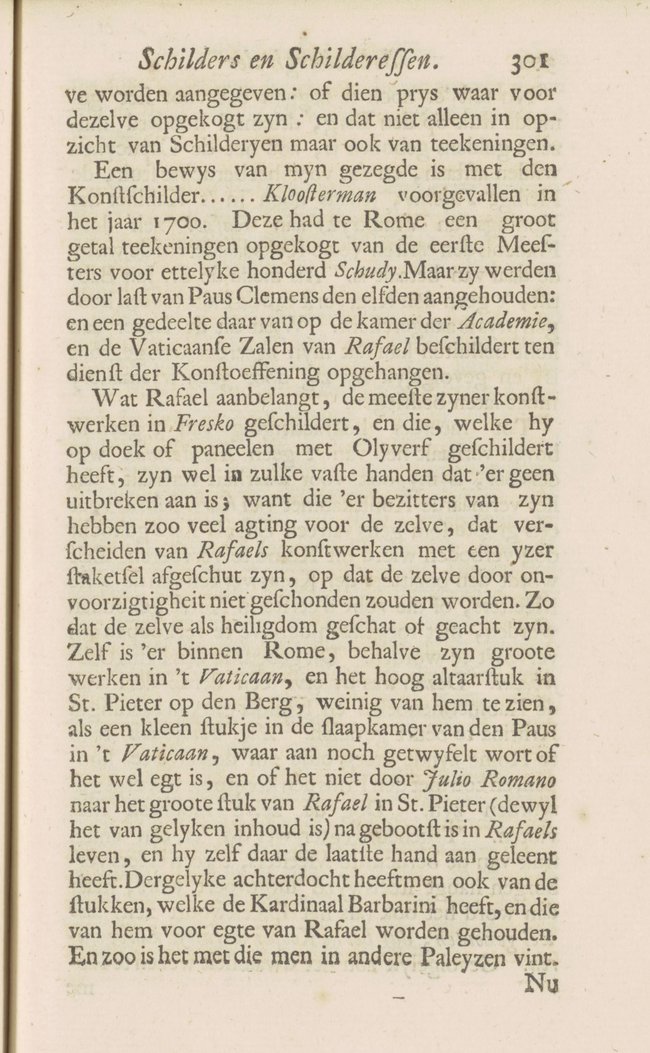

1
Rafaël Raphael
Transfiguration, c. 1518-20
Rome, Musei Vaticani, inv./cat.nr. 333
Page 302
It now remains for me to say that three times hundred thousand guilders were offered for the mentioned piece in Montorio the Capuchins been prepared to part with it, and that for the famous piece, The Holy Family (now still in the cabinet of the kings of France) [2], Raphael himself was paid 5,000 rixdoller or its worth by François I, as well as the Saint John the Baptist for which the Elector Palatine was charged a high price [3]. From this the reader can easily conclude that my suspicions are grounded and that as a consequence he should not let himself be fooled by deception.
As further confirmation of what I have told above about what Closterman experienced, it has also been told to me as truth that the famous art cabinet of Carlo Maratta was bought from an English lord for a great sum of money but was not allowed to be moved from Rome. The owners of art work by the best masters, or ones that are first introduced to art, are not permitted to sell or transport them. This happened to Prince Livio Odescalchi. The inheritance of a third part of the cabinet furniture and paintings of Queen Christina had come his way. Augustinus Terwesten [= Ezaias Terwesten], then being in Rome, received an order to purchase them and would presumably have come to an agreement with the prince regarding the sale. But this did not fly. However, it has happened that an occasional piece by one of the most famous masters, which hung hidden elsewhere, was stealthily exported. But then is (as the proverb says) so well-salted that the buyer has to hang on to it. As a consequence it would be folly
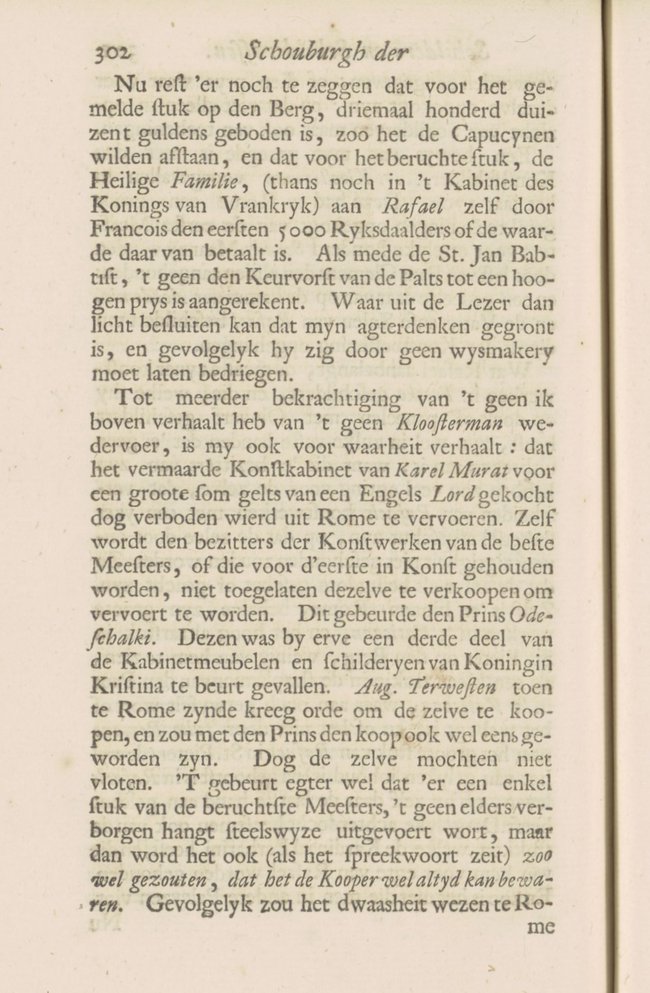

2
Rafaël Raphael
The Holy Family of Francis I, 1518
Paris, Musée du Louvre, inv./cat.nr. 604

3
Daniele da Volterra
John the Baptist
Munich, Alte Pinakothek, inv./cat.nr. 499
Page 303
to buy art in Rome (where commendable art is more valued than here in this country) to sell it elsewhere.
Among those who in their youth took diligent and industrious advantage of their student years is also counted JAN de BAEN, born in Haarlem on the 20th of February 1633.
His father was a merchant in linen and flax, but he and his wife were mowed down by the scythe of death when Jan was only three years old. From which time his uncle Hindrick Pijman, captain and in his forties in Emden (who also practiced the art of painting after the manner of Jan Brueghel I, nicknamed the Velvet) took him into his home and taught him the rudiments of art. He also went to great trouble for him, seeing he was clever and able to turn his hands to anything, even to sewing and knitting and other female activities on winter evenings, in which his mother took great pleasure and, as company, also had him read the books of Amadís de Gaula. But he always had more inclination to read the lives of the painters, described by Karel van Mander I, to which she never needed to exhort him.
In the year 1645 this uncle came to die and the next year, then being 13 years old, he was placed in Amsterdam to continue learning art under the supervision of the painter Jacob Adriaensz. Backer, where he practiced art all day with diligence and then half the night at his home, so that his female guardian, with whom he lived, often grumbled.
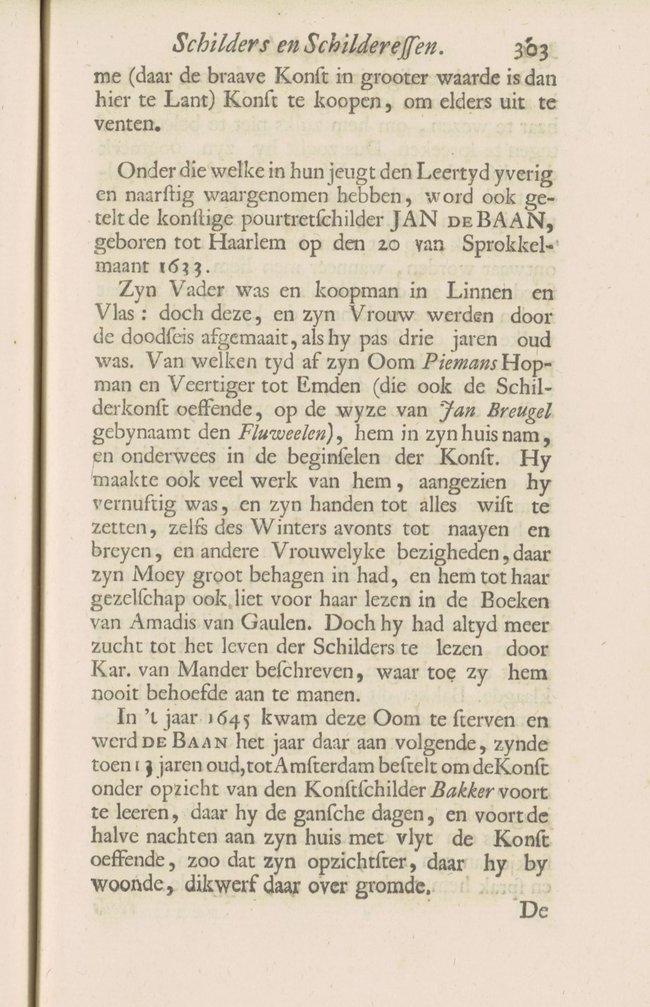
Page 304
The need to make use of his time, early and late, did not seem to be enough reason for her not to want to prevent it or controvert it. Thus he sought to reach his goal by a ruse. What did he do? He stacked the table and chairs on top of each other and made a scaffold in the chimney of his room, so that the light would not be noticed when they came to spy on him, and he often sat there drawing so long, and so late into the night that he could no longer direct his drawing pen due to the numbness caused by the cold coming down the chimney (What you do willingly, the saying goes, is no burden) and he would be compelled to go to his bed.
By this zeal he progressed so far in painting and drawing that his fellow students envied him because of it, ridiculing and hindering his work, sometimes smearing his work and tools with muck and filth, which he always endured without complaining to his teacher, until one day the latter came unexpectedly into his studio and found him crying. He tried to hide this but when pressed he complained about his plight. Not willing to tolerate this injustice, Backer gave these malevolent boys a severe going-over, punishing them more than a little, saying among other things that they were spiteful animals and that none of them would ever reach as high in art as this young lad already had. Bernard Vaillant the pastellist was one of those fellows. Backer took the piece from De Baen's easel and brought it into his room, restoring his courage by saying: You are
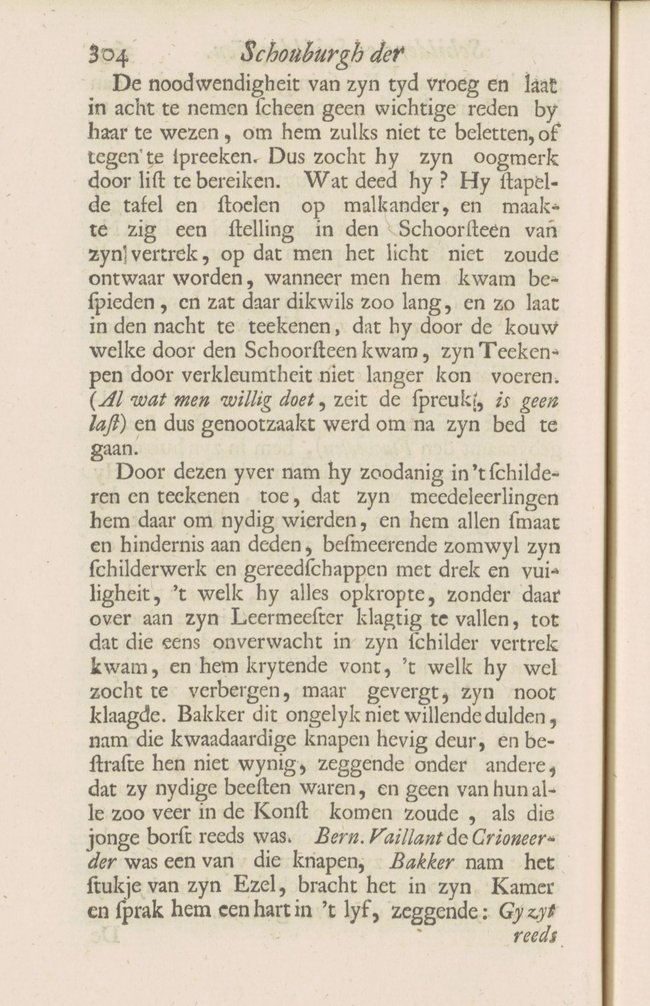
Page 305
already a master of art, and no one will ever (it was a bust of a woman) improve on that. He kept this work in mind and showed it off as an amazing feat to all connoisseurs of art who came to visit him, who praised it for being natural, round and strongly painted.
After this time Backer took him along when he went amongst company and did not fail to praise his work when appropriate, to make him known, until with his 18th year, when he dutifully thanked his instructor and set out to test what he could achieve on his own.
Now he had to conceive of a way of painting that was praiseworthy, so as to adhere to it. The brushwork of Anthony van Dyck was highly esteemed, and that of Rembrandt also had many adherents. He napped for a long time at this crossroad not knowing which way was best taken, but chose the handling of the former, being of a more permanent nature, as his model.
In the year 1660 he was attracted from Amsterdam to The Hague by a gentleman amateur of art, who all at once put him on the hay wagon of his fortune, for he immediately received as much work as he could carry out from people of the highest status. Amongst these were the Count of Hoorn, the Prince of Tarente [= Henri Charles de La Trémoille] and others, by which the reputation of his work spread to neighbouring England, so that King Charles II of England not only had him sent for but also had him brought by lord Killigrew on the royal yacht to paint his and the queen's portraits. On this occasion he also painted various others at the court, so that
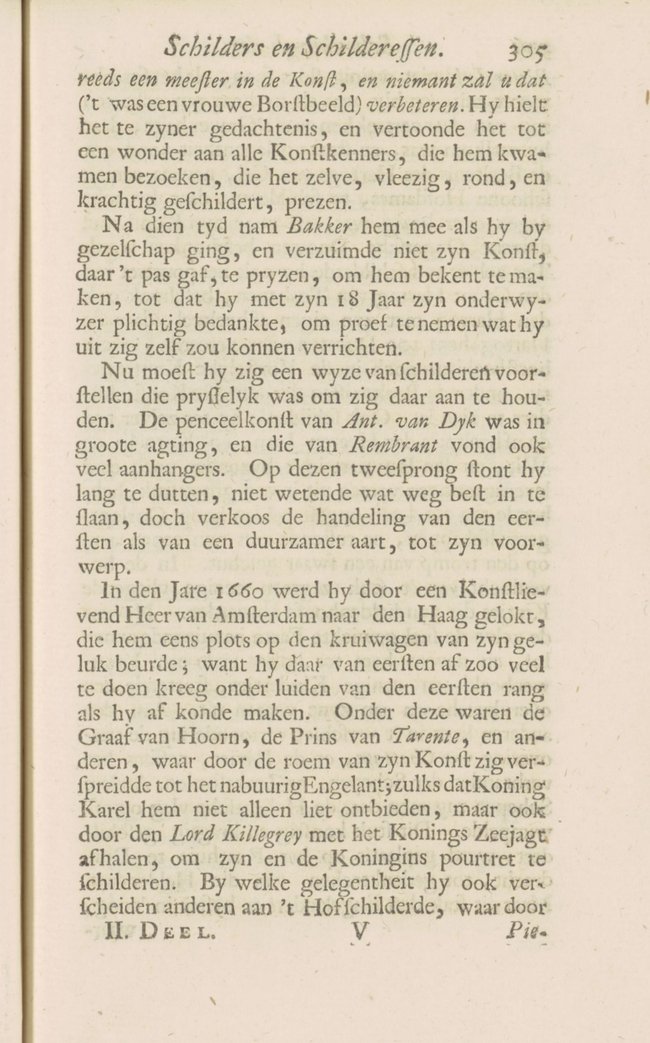
Page 306
Peter Lely was more than a little envious and wove a veil, as the saying goes, and was happy to see him from behind as he departed from there for The Hague, where he was welcome and immediately received an opportunity to paint the portrait of the Duke of Celle [= Christian Ludwig von Braunschweig-Lüneberg] [3] as well as some beautiful ladies of the court, which occupied for him eight days, and was rewarded for his art with a thousand Hungarian ducats. At this time he also painted the portrait of Cosimo III de' Medici, the Grand Duke of Tuscany and also presented the Duke with his own likeness, for which the Duke honoured him with 100 ducats. This portrait bust still hangs in the princely art gallery, to be seen in the company of portraits by the most distinguished artists. At this time he also painted portraits of the gentlemen Johan and Cornelis de Wit [4-5], and the Pensionary in particular once more in full-length in a large piece having piled-up weapons of war for a seat and resting his arm on the muzzle of a canon. In the sky at the top of the picture one saw flying cherubs crowning his heroic head with laurel leaves. Next to these was fleet-winged Fame trumpeting his honour, and to the left of him the figure of a woman with several cherubs, emptying a horn of plenty at his feet. On the other side, in the distance, could be seen the raid on Chatham, the river along with the burning of ships, and the sea fortresses. Other ships are seen flying the flag of Holland. This artistic and powerful painting was placed in the town hall of Dordrecht as a memorial to that heroic deed. But this poked the English too much in the eye,
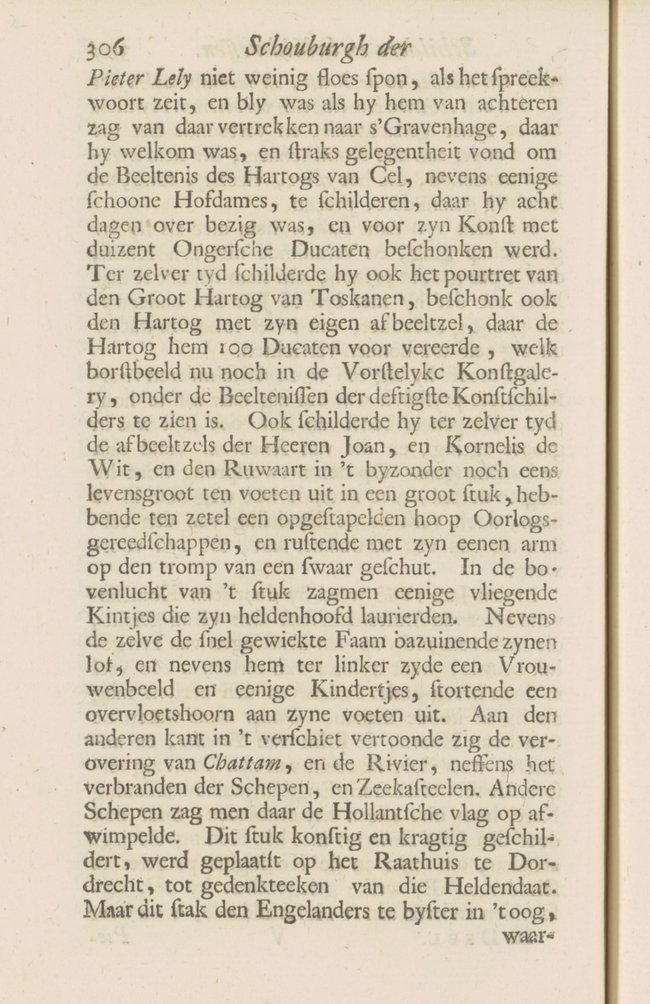

3
possibly after Jan de Baen
Portrait of Christian Ludwig von Braunschweig-Lüneberg (1622-1665), 1660 or later
Celle, Bomann Museum

4
and studio of Jan de Baen Jan de Baen
Portrait of Johan de Witt (1625-1672), 1669 ?
Dordrecht, Dordrechts Museum, inv./cat.nr. DM/895/377

5
and studio of Jan de Baen Jan de Baen
Portrait of Cornelis de Witt (1623-1672), c. 1669
Dordrecht, Dordrechts Museum, inv./cat.nr. DM/895/378
Page 307
for which reason it was also included with the causes for war as a grievance (on the argument that the Crown of England was injured by being placed under the feet of the victor). They say as well that it had been painted there at first, but when first seen by a lord, was wiped away again. Yet Daniël Vincentius, who is married to De Baen's daughter, explains to me in a letter written on the 2nd of February 1717, that this never happened, and that he also could not detect any such thing in the piece, particularly at the bottom, or in the cornucopia, which has always been painted with symbols of Luxury and not with anything resembling a crown or sceptre, and that consequently this had only been a rumour and a pretext for war. The following verse, referring to the above-mentioned work of art, came into my hands and, not inappropriately, I thought to place it here.
Thus art comes to paint de Witt,
And the land of Britain, surrounded by sea,
The Thames and the curved bay of Chatham.
Thus chains and palisades are broken.
Here the British Fleet ends up aflame,
With all who flee the flames on the beach.
Still another.
This is the true image of Virtue and Bravery,
The Pensionary, on whose wisdom, and good leadership,
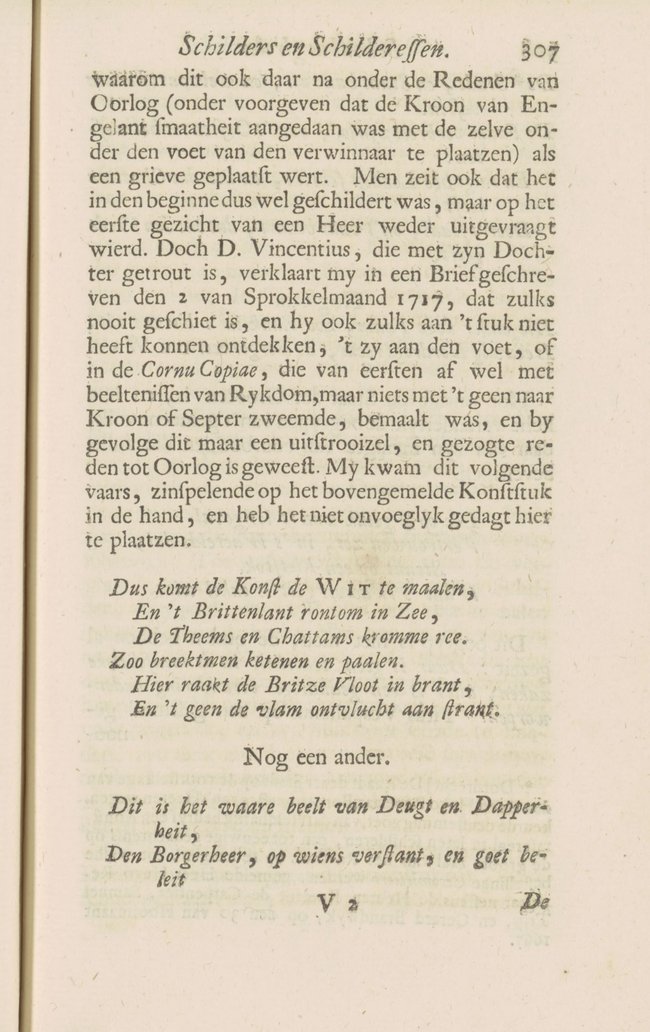
Page 308
The City* and State can base their peace and prosperity.
Fame spreads his praise, from East to West:
And witnesses London's fear, and Chatham's cringing,
Imperilled by the steel and fire that give us peace.
Yet one more.
He who below this Fame, so bright in harness sits,
Is Dordrecht's eternal renown, the Pensionary De Wit.
How uncertain the position of the great is, and how easily the attitude of common people changes, is proved by many examples.
He who puts his faith in the fortune
Of chance occurrence in this vale of the world;
Leans on a reed.
For the things of this world are only wind.
This concept is not new. The ancients already said: There is no certainty in human affairs; everything is subject to constant change. Titus Vespasian, invited to a dinner
--------
* Dordrecht. The council of this city, at the proposal of Mister Hugo Repelaer, church-sponsored burgomaster, unanimously approved to have an artwork painted of that heroic action to hang in eternal remembrance in the great room of the city hall, to which commission were delegated mentioned Mister Hugo Repelaer as well as Misters Roeland de Carpentier, Samuel Trip and Gerard Brandwyk on the 30th of July 1667.
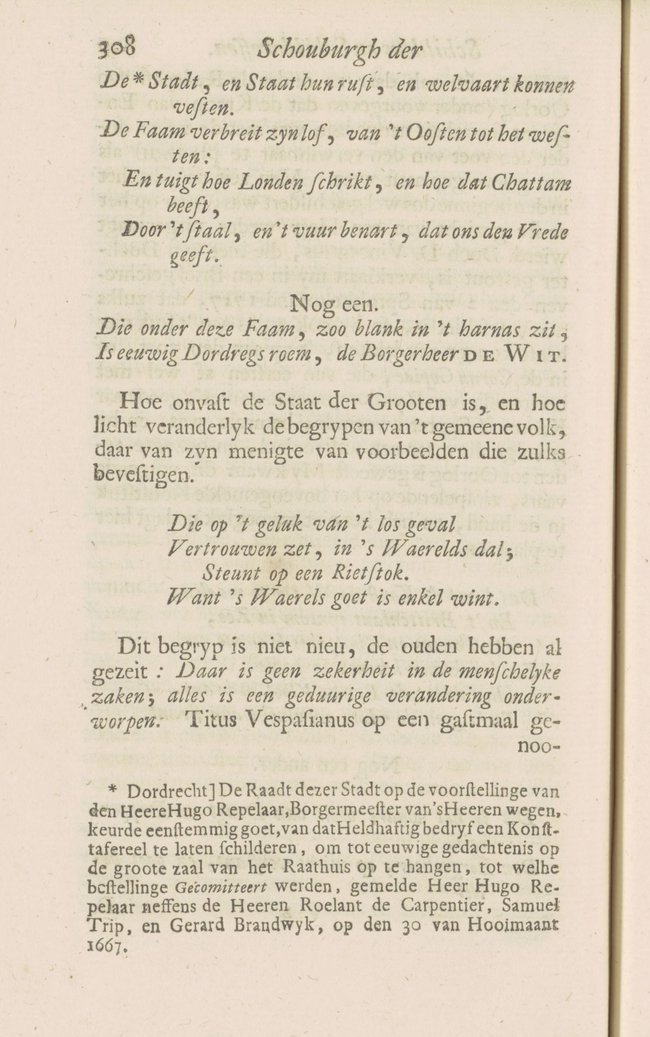
Page 309
at which everyone was cheerful, heaved a great sigh. When his friends asked him after the reason for his sighing, he gave as reply: I cannot keep myself from it, when I consider that my honour and greatness depend on the favour of unstable Fortune, that my lands are, as it were, in the power of two Arbiters, and my life as if in that of mercenaries. This was (to digress no more widely) realized by the Pensionary, the depiction of whose apotheosis we described. He who performed the deed at Chatham on the 21st, 22nd and 23rd of July 1667, was rewarded by the States General with a golden cup and extolled by everyone. Later he was murdered along with his brother by the burghers of The Hague, motivated by self-interest, and grossly abused by the maddened rabble on the 20th of August 1672. Bitterness against these gentlemen ran so high that they even tried to destroy their portraits. Several times the seething populace massed in front of the house of our painter, threatening to tear down his house if he did not hand over the portraits of the gentlemen Johan and Cornelis de Wit. This had been revealed by one of his students (who also mingled in the crowd), so that De Baen had to open his door to stay out of harm’s way and protect his house from damage (the paintings having been securely hidden), and to look on with resignation as they searched his whole house and in all the cupboards and chests from top to bottom.
The craze for iconoclasm spread further to Dordrecht, where the mob tore apart the masterpiece of this man's art located in the town hall (which we just
